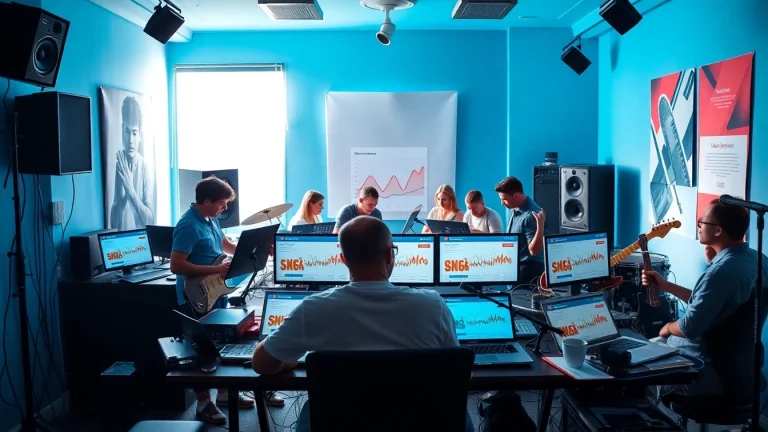
Mastering the Art of Music Pitching: Strategies for Success
Understanding Music Pitching Basics
What is Music Pitching?
Music pitching is the process of presenting your music to curators, industry professionals, or influencers with the hope of getting your tracks featured on playlists, blogs, or radio stations. This process can take many forms, from sending an email with a link to your track to a personalized submission through dedicated platforms. The ultimate goal is to amplify the reach of your music and connect with potential listeners and fans.
The Importance of Effective Music Pitching
In today’s digital age, effective music pitching can be a game changer for emerging artists. The music industry is highly competitive, and with millions of tracks being uploaded daily, standing out is crucial. Effective pitching ensures that your music gets the attention it deserves and can significantly increase your plays, streams, and overall audience engagement. Having good pitching strategies can open doors to opportunities such as collaborations, live performances, and even record label interest.
Common Misconceptions About Music Pitching
Many misunderstand the music pitching process. Here are a few common misconceptions:
- It’s Only for Major Labels: Independent artists can and should pitch their music just like industry giants.
- Only Professionals Can Pitch: Artists need to learn how to pitch their music themselves to build strong connections.
- Mass Send-Outs Are Effective: A tailored pitch to targeted curators usually yields better results than mass emailing.
Identifying Your Target Audience for Music Pitching
Who to Pitch Your Music To
Identifying the right audience for your music is crucial. Potential targets include:
- Playlist Curators: These individuals manage playlists on streaming platforms and can greatly influence how many people hear your music.
- Music Bloggers: Blogs can build credibility and introduce your music to niche audiences.
- Record Labels: Even if you’re independent now, establishing relationships with labels can lead to future opportunities.
- Music Influencers: Collaborating with influencers can expand your reach on social media.
Understanding Playlist Curators and Their Needs
Each playlist curator has their own unique style and preferences, making it essential to understand what they seek in a submission. Many curators look for:
- Originality: Unique sounds and styles that stand out.
- Marketability: Music that fits their audience’s tastes.
- High-Quality Production: Professionally produced tracks are more likely to get attention.
Researching Potential Opportunities
Thorough research can identify relevant curators and platforms for your music. Use social media, streaming services, and music blogs to find curators in your genre. Tools like music pitching platforms can also provide valuable data and insights about potential leads.
Crafting Your Music Pitch
Elements of a Strong Pitch
A solid music pitch should include:
- Personalization: Address the curator by name and reference their previous work.
- Clear Subject Line: Make your purpose clear from the get-go.
- Brief Description: Include essential details about your music, such as genre, influences, and notable achievements.
- Links: Provide direct links to your music, bio, and social media accounts.
Writing Engaging and Concise Pitch Emails
Keep your pitch email professional yet engaging. Start with a hook to grab the curator’s attention, then follow with your details. Use clear and concise language while maintaining a tone that reflects your personality.
Using Visual Content to Enhance Your Pitch
Incorporating visual media can make your pitch stand out. High-quality images, cover art, and music videos can provide a fuller picture of your brand as an artist and engage curators more effectively.
Executing Your Pitch Strategy
Timing Your Submissions Effectively
When you send your pitch can be as important as how you send it. Many curators prefer to receive music at least a week before the release date, giving them time to consider and add songs to their playlists. Always check their submission guidelines and respect deadlines.
Follow-Up Etiquette Post-Pitch
A follow-up can be helpful, but timing is everything. Wait at least one to two weeks after your initial pitch before reaching out again. Keep it brief and respectful, expressing gratitude and reasserting your interest in their feedback.
Leveraging Social Media for Pitch Success
Social media can serve as a powerful tool for establishing relationships and promoting your music. Engage with curators on platforms like Twitter or Instagram; comment on their posts and share your music’s journey. Building genuine connections can lead to more successful pitches down the line.
Measuring the Success of Your Music Pitching Efforts
Analyzing Response Rates
Tracking how many pitches result in placements is a good way to gauge effectiveness. Use spreadsheets to record successes and failures, noting which styles of pitches yield better responses and adapting your strategies accordingly.
Adjusting Strategies Based on Feedback
Feedback is invaluable. If curators provide comments, take them seriously. Use constructive feedback to refine your pitch emails and music itself, improving your chances of success in future submissions.
Building Long-Term Relationships with Curators
Music pitching shouldn’t be a one-off action. Regular follow-ups and maintaining communication with curators can lead to a stronger rapport, making them more inclined to support your future releases. Show appreciation for their work and keep them updated on your musical journey.


